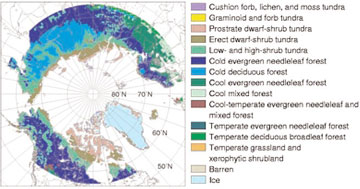Global warming causing disappearance of tundra in Canada
Global warming causing disappearance of tundra in Canada
mongabay.com
March 5, 2007
Tundra in northern Canada is being replaced at a rapid rate by boreal forests according to a new study published in the Journal of Ecology. Researchers say global warming is to blame.
“The conventional thinking on treeline dynamics has been that advances are very slow because conditions are so harsh at these high latitudes and altitudes,” said Dr. Ryan Danby, a biologist at the University of Alberta and lead author of the study. “But what our data indicates is that there was an upslope surge of trees in response to warmer temperatures. It’s like it waited until conditions were just right and then it decided to get up and run, not just walk.”
 Present day natural vegetation of the Arctic and neighboring regions from floristic surveys. Courtesy of NOAA |
Danby and Dr. David Hik, also a biologist at the University of Alberta, used tree rings to reconstruct changes in treeline vegetation. They found that “treeline advanced considerably—as much as 85 metres elevation—on warm, south-facing slopes and tree density increased significantly—as much as 65 per cent—on cooler, north-facing slopes,” according to a release from the university.
“The mechanism of change appears to be associated with occasional years of extraordinarily high seed production—triggered by hot, dry summers—followed by successive years of warm temperatures favourable for seedling growth and survival,” Danby added. “These results are very relevant to the current debate surrounding climate change because they provide real evidence that vegetation change will be quite considerable in response to future warming, potentially transforming tundra landscapes into open spruce woodlands.”
Other research indicated the thawing of Arctic tundra could worsen climate change by releasing large amount of stored carbon into the atmosphere. Further studies suggest that tree growth in northern latitude can contribute to climate warming by absorbing larger amounts of sunlight.
CITATION: Danby, R.K. and Hik, D.S. (2007) Variability, contingency and rapid change in recent subarctic alpine tree line dynamics. Journal of Ecology – Vol. 95 Issue 2 pages 352—363